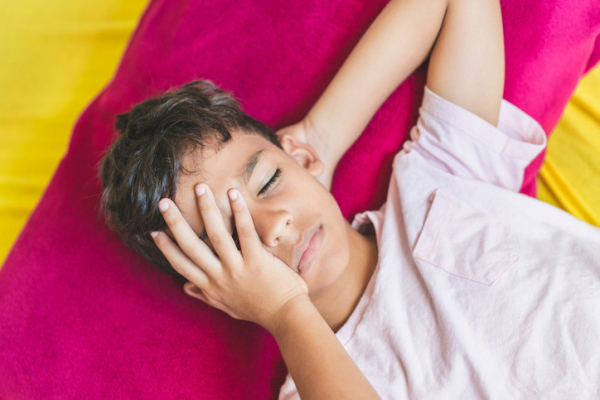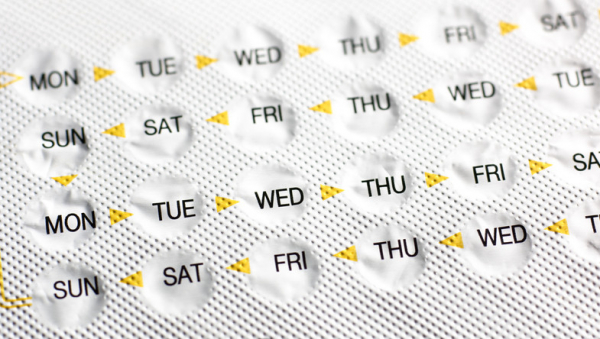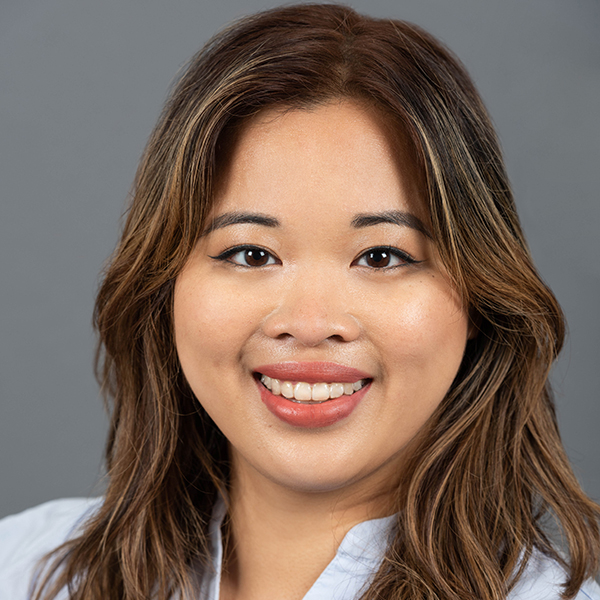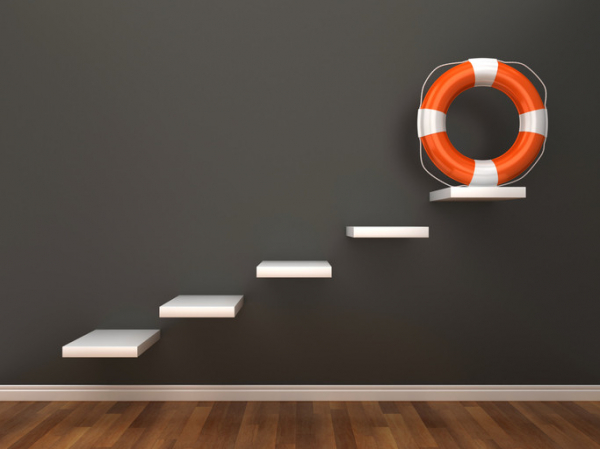
Do children get migraine headaches? What parents need to know

Headaches are very common in children and teens. In fact, more than half will suffer from headaches at some point, and by 18 years the majority of adolescents have had them. And while most headaches are part of a viral illness, some are migraines. In fact, recurring migraines affect as many as one in 10 children and teens overall.
What should you know — and do — if you think your child or teen may be having migraines?
How early do migraines start to occur?
We don’t tend to think about migraines in children, but by age 10, one in 20 children has had a migraine. And migraines sometimes occur even earlier.
Before puberty, boys and girls are equally likely to have them. After puberty, migraines are more common in girls.
Which migraine symptoms are most common in children?
Migraines are often one-sided in adults. In children they are more likely to be felt on both sides of the head, either in both temples or both sides of the forehead.
While it’s not always easy to tell a migraine from another kind of headache, children
- often report throbbing pain
- may experience nausea and sensitivity to light and noise.
The flashing lights and other vision changes people often see as a migraine begins are less common in children. However, parents may notice that their child is more tired, irritable, or pale before a migraine begins — and takes a while to get back to normal after it ends.
What causes migraines in children?
We don’t know exactly what causes migraines. We used to think it had to do with blood flow to the brain, but that does not seem to be the case. It appears that migraines are caused by the nerves being more sensitive, and more reactive to stimulation. That stimulation could be stress, fatigue, hunger, almost anything.
Migraines run in families. In fact, most migraine sufferers have someone in the family who gets migraines too.
Can migraines be prevented?
The best way to prevent migraines is to identify and avoid triggers. The triggers are different in each person, which is why it’s a good idea to keep a headache diary.
When your child gets a headache, write down what was happening before the headache, how badly it hurt and where, what helped, and anything else about it you can think of. This helps you and your doctor see patterns that can help you understand your child’s particular triggers.
It’s a good idea to make sure your child gets enough sleep, eats regularly and healthfully, drinks water regularly, gets exercise, and manages stress. Doing this not only helps prevent migraines, but is also good for overall health!
How can you help your child ease a migraine?
When a migraine strikes, sometimes just lying down in a dark, quiet room with a cool cloth on the forehead is enough. If it’s not, ibuprofen or acetaminophen can be helpful; your doctor can tell you the best dose for your child.
It’s important not to give your child these medications more than about 14 days a month, as giving them more often can lead to rebound headaches and make everything worse!
Are there prescription medicines that can help children with migraines?
If those approaches aren’t enough, a class of medications called triptans can be helpful in stopping migraines in children ages 6 and up.
If a child experiences frequent or severe migraines, leading to missed days of school or otherwise interfering with life, doctors often use medications to prevent migraines. There are a number of different kinds, and your doctor can advise you on what would be best for your child.
Some girls get migraines around the time of their period. If that happens frequently, sometimes taking a prevention medicine around the time of menses each month can be helpful.
When to contact your doctor
If you think your child might be having migraines, you should call and make an appointment. Bring the headache diary with you. Your doctor will ask a bunch of questions, do a physical examination, and make a diagnosis. Together you can come up with the best plan for your child.
You should always call your doctor, or go to an emergency room, if your child has a severe headache, a stiff neck, trouble with coordination or movement, is abnormally sleepy, or isn’t talking or behaving normally.
The American Academy of Pediatrics has additional useful information about migraines, and how to treat and prevent them, on their website.
About the Author

Claire McCarthy, MD, Senior Faculty Editor, Harvard Health Publishing
Claire McCarthy, MD, is a primary care pediatrician at Boston Children’s Hospital, and an assistant professor of pediatrics at Harvard Medical School. In addition to being a senior faculty editor for Harvard Health Publishing, Dr. McCarthy … See Full Bio View all posts by Claire McCarthy, MD

Opill: Is this new birth control pill right for you?

Birth control pills have been safely used in the US (and sold only by prescription) for more than half a century. In 2023 the FDA approved Opill, the first daily contraceptive pill intended for sale over the counter with no prescription needed. This offers many more people access to a new nonprescription option for preventing pregnancy.
Opill is available online and soon to be stocked on drugstore shelves. Here’s what anyone interested — adults, parents, and teens — should know.
What is in Opill and how does it work?
Opill is a progestin-only form of birth control. That means it uses a single hormone called progestin (or norgestrel) to prevent pregnancy. It works by
- affecting ovulation so that the ovaries do not release an egg every month
- thickening cervical mucus, which blocks sperm from reaching an egg
- changing the uterine lining in ways that keep a fertilized egg from implanting.
How effective is Opill at preventing pregnancy?
It depends on how consistent you are about taking Opill:
- Perfect use means taking the pill every single day at the same time. With perfect use, Opill is 98% effective. That means that if 100 people take the medication perfectly, two or fewer people would become pregnant. Taking a pill perfectly can be difficult, though.
- Typical use averages how well a method works to prevent pregnancy when real people use it in real life. It considers that people sometimes use the pill inconsistently, like forgetting a dose or not taking it at the same time every day. With typical use, Opill is 91% effective. This means that if 100 people use Opill, but don’t take it perfectly, at least nine could become pregnant in a year.
It’s also important to know that some medications make Opill less effective at preventing pregnancy. These include medicines used to treat migraines and seizures. Even though this birth control pill will be available over the counter, you should ask your health care provider if any medicines you take could make it less effective.
How do you take Opill?
- Take it once a day at the same time each day until you finish the entire pack.
- Sticking to a consistent time of day, every day, is crucial. Timing matters with progestin-only pills like Opill because this medication works by raising progestin levels. However, progestin only stays elevated for 24 hours after you take each pill. After that, the progestin level will return to normal.
- After you complete a 28-day pack, you should immediately start a new pack of pills the next day.
What happens if you forget to take a dose at the specific time or miss a dose?
- If you take the pill more than three hours late it will not be as effective at preventing pregnancy.
- Take the missed pill as soon you remember.
- You will need to use a backup birth control method such as condoms every time you have sex for the next 48 hours.
Is Opill safe for teenagers?
Opill is generally safe for most people who could get pregnant, including teenagers. There’s no evidence to suggest that safety or side effects are different in teenagers compared with adults.
Research done by the manufacturer has established the safety of Opill in people as young as 15 years old. It will be available without an age restriction.
When teens use birth control, what is the best choice for them?
There isn’t a one-size-fits-all birth control method for all teenagers. The best method is the one a teen personally prefers and is committed to using consistently.
For teens who struggle with taking medication at the same time every day –– or anyone else who does –– Opill may not be the right choice. Fortunately, there are many options for preventing pregnancy, catering to individual preferences and goals.
Learn more about different contraception methods at the Center for Young Women’s Health website.
What side effects are common with Opill?
Progestin-only pills are usually associated with mild side effects. The most common side effects are:
- unexpected vaginal bleeding or spotting
- acne
- headache
- gastrointestinal symptoms such as nausea, abdominal pain, and bloating
- change in appetite.
Opill does not cause problems with getting pregnant in the future, or cause cancer. Unlike birth control pills that combine the hormones estrogen and progestin, Opill will not increase the risk of a developing a blood clot.
Will Opill cause any mood changes?
Research looking at possible effects of progestin-only pills on mood is limited, so this is unclear. We do know that most people who take hormonal birth control methods do not experience negative mood changes.
Fortunately, there are many different types of effective birth control. If one method causes you unwanted side effects, talk to your health care provider. Together, you can figure out if another type of birth control may work better for you.
Can it be used as emergency birth control?
No, it should not be used as emergency birth control.
What should you know about STIs?
This type of birth control does not protect you from sexually transmitted infections (STIs) such as syphilis, gonorrhea, or chlamydia.
You can reduce the chance of getting STIs by correctly using condoms each time you have sex. There are different types of condoms: one made for penises and one made for vaginas.
Vaccines help protect against some STIs such as hepatitis B and human papillomavirus (HPV). A medicine called PrEP can help prevent HIV. Ask your medical team for more information about the right choices for you.
About the Authors

Candice Mazon, MD, Contributor
Dr. Candice Mazon is a second year adolescent medicine fellow at Boston Children's Hospital. She's a board certified pediatrician and received her training at MedStar Georgetown University Hospital. She earned her MD degree from Drexel University … See Full Bio View all posts by Candice Mazon, MD 
Amy Desrochers DiVasta, MD, MMSc, Contributor
Amy Desrochers DiVasta MD, MMSc, is chief of the division of adolescent medicine at Boston Children’s Hospital. She is the co-director of the adolescent long-acting reversible contraception program, and co-director of the reproductive endocrinology and PCOS … See Full Bio View all posts by Amy Desrochers DiVasta, MD, MMSc

Ever worry about your gambling?

Are online gambling and sports betting new to your area? Are gambling advertisements catching your eye? Have you noticed sports and news shows covering the spread? Recent changes in laws have made gambling widely accessible, and its popularity has soared.
Occasional bets are rarely an issue. But uncontrolled gambling can lead to financial, psychological, physical, and social consequences, some of which are extreme. Understanding whether gambling is becoming a problem in your life can help you head off the worst of these issues and refocus on having more meaning, happiness, and psychological richness in your life. Gambling screening is a good first step.
Can you screen yourself for problem gambling?
Yes. Screening yourself is easy. The Brief Biosocial Gambling Screen (note: automatic download) is a validated way to screen for gambling disorder. It has three yes-or-no questions. Ask yourself:
- During the past 12 months, have you become restless, irritable, or anxious when trying to stop/cut down on gambling?
- During the past 12 months, have you tried to keep your family or friends from knowing how much you gambled?
- During the past 12 months, did you have such financial trouble as a result of your gambling that you had to get help with living expenses from family, friends, or welfare?
What do your answers mean?
Answering yes to any one of these questions suggests that you are at higher risk for experiencing gambling disorder. Put simply, this is an addiction to gambling. Like other expressions of addiction, for gambling this includes loss of control, craving, and continuing despite bad consequences. Unique to gambling, it also often means chasing your losses.
A yes doesn’t mean that you are definitely experiencing a problem with gambling. But it might be valuable for you to seek a more in-depth assessment of your gambling behavior. To find an organization or person qualified to help, ask a health care provider, your local department of public health, or an advocacy group like the National Council on Problem Gambling.
Are you ready for change?
Your readiness to change a behavior matters when deciding the best first steps for making a change. If someone asks you whether you want to change your gambling, what would you say?
|
I never think about my gambling. |
Sometimes I think about gambling less. |
I have decided to gamble less. |
I am already trying to cut back on my gambling. |
I changed my gambling: I now do not gamble, or gamble less than before. |
Depending on your answer, you might seek out different solutions. What’s most important initially is choosing a solution that feels like the right fit for you.
What if you don’t feel ready to change? If you haven’t thought about your gambling or only occasionally think about changing your gambling, you might explore lower intensity actions. For example, you could
- read more about how gambling could create a problem for you
- listen to stories of those who have lived experience with gambling disorder.
If you are committed to making a change or are already trying to change, you might seek out more engaging resources and strategies to support those decisions, like attending self-help groups or participating in treatment.
Read on for more details on choices you might make.
What options for change are available if you want to continue gambling?
If you want to keep gambling in some way, you might want to stick to lower-risk gambling guidelines:
- gamble no more than 1% of household income
- gamble no more than four days per month
- avoid regularly gambling at more than two types of games, such as playing the lottery and betting on sports.
Other ways to reduce your risk of gambling harm include:
- Plan ahead and set your own personal limits.
- Keep your entertainment budget in mind if you decide to gamble.
- Consider leaving credit cards and debit cards at home and use cash instead.
- Schedule other activities directly after your gambling to create a time limit.
- Limit your use of alcohol and other drugs if you decide to gamble.
What are easy first steps toward reducing or stopping gambling?
If you’re just starting to think about change, consider learning more about gambling, problem gambling, and ways to change from
- blogs, like The BASIS
- books like Change Your Gambling, Change Your Life
- podcasts like After Gambling, All-In, and Fall In, which offer expert interviews, personal recovery stories, and more.
Some YouTube clips demystify gambling, such as how slot machines work, the limits of skill and knowledge in gambling, and how gambling can become an addiction. These sources might help you think about your own gambling in new ways, potentially identifying behaviors that you need to change.
What are some slightly more active steps toward change?
If you’re looking for a slightly more active approach, you can consider engaging in traditional self-help experiences such as helplines and chatlines or Gamblers Anonymous.
Another option is self-help workbooks. Your First Step to Change is a popular workbook that provides information about problem gambling, self-screening exercises for gambling and related conditions like anxiety and depression, and change exercises to get started. A clinical trial of this resource suggested that users were more likely than others to report having recently abstained from gambling.
Watch out for gambling misinformation
As you investigate options, keep in mind that the quality of information available can vary and may even include misinformation. Misinformation is incorrect or misleading information. Research suggests that some common types of gambling misinformation might reinforce harmful beliefs or risky behaviors.
For example, some gambling books, websites, and other resources exaggerate your likelihood of winning, highlight win and loss streaks as important (especially for chance-based games like slots), and suggest ways to change your luck to gain an edge. These misleading ideas can help you to believe you’re more likely to win than you actually are, and set you up for failure.
The bottom line
Taking a simple self-screening test can start you on a journey toward better gambling-related health. Keep in mind that change can take time and won’t necessarily be a straight path.
If you take a step toward change and then a step back, nothing is stopping you from taking a step forward again. Talking with a care provider and getting a comprehensive assessment can help you understand whether formal treatment for gambling is a promising option for you.
About the Author

Debi LaPlante, PhD, Contributor
Dr. Debi LaPlante is director of the division on addiction at the Cambridge Health Alliance, and an associate professor of psychiatry at Harvard Medical School. She joined the division in 2001 and is involved with its … See Full Bio View all posts by Debi LaPlante, PhD